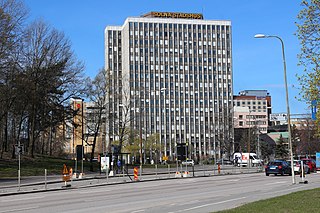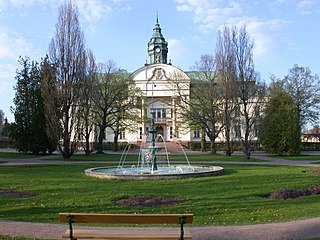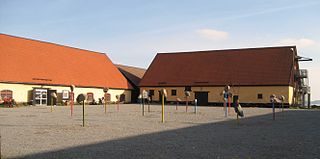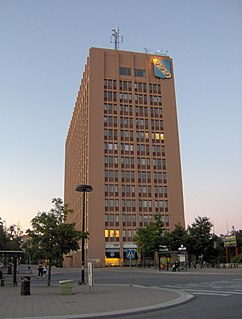
Zealand at 7,031 km2 is the largest and most populous island in Denmark proper. Zealand had a population of 2,319,705 on 1 January 2020.

Solna Municipality is a municipality in Stockholm County in Sweden, located just north of Stockholm City Centre. Its seat is located in the town of Solna, which is a part of the Stockholm urban area. Solna is one of the richest municipalities in Sweden.

Sollentuna Municipality is a municipality in Stockholm County in east central Sweden, north of Stockholm. Its seat of local government is located in Tureberg, which is a part of the Upplands Väsby urban area.

Västergötland, also known as West Gothland or the Latinized version Westrogothia in older literature, is one of the 25 traditional non-administrative provinces of Sweden, situated in the southwest of Sweden.

Värmland is a landskap in west-central Sweden. It borders Västergötland, Dalsland, Dalarna, Västmanland, and Närke, and is bounded by Norway in the west. Latin name versions are Varmelandia, Vermelandia, Wermelandia, Værmalandia, Værmolandia, Virmolandia and Vermillandia. Some of the Latinised forms show the origin of the name to come from the large local lake by the name of Värmeln ; others from the river name *Værma, the main outlet of that lake. The province was originally part of Götaland, and became part of Svealand in 1815.

Sollentuna Hundred was a hundred of Uppland in Sweden. It encompassed the present-day municipalities of Järfälla, Sollentuna, and Sundbyberg as well as parts of Upplands Väsby Municipality and Stockholm. All are now part of Stockholm County. The hundred had three köpingar—Sollentuna Köping, Sundbybergs Köping, and Hässelby Villastads Köping—and a number of municipalsamhällen. Most of the hundred is now part of the urban area of Stockholm, but the larger part of in the remainder is in Upplands Väsby. The total area was around 197 km2 and the population in 1916 was 20,727 people.

Sölvesborg is a locality and the seat of Sölvesborg Municipality in Blekinge County, Sweden with 10,024 inhabitants in 2013.

Motala is a locality and the seat of Motala Municipality, Östergötland County, Sweden with 29,823 inhabitants in 2010. It is the third largest city of Östergötland, following Linköping and Norrköping. Motala is situated on the eastern shore of Lake Vättern and is regarded as the main centre of both the Göta Canal and the surrounding lake region.

Nyköping is a locality and the seat of Nyköping Municipality, Södermanland County, Sweden with 32,759 inhabitants as of 2017. The city is also the capital of Södermanland County.

The Battle of Brunkeberg was fought on 10 October 1471 between the Swedish regent Sten Sture the Elder and forces led by Danish king Christian I. Sture won a decisive victory.
Denmark has long been involved with the wars of Northern Europe and, recently, elsewhere. In the early Middle Ages, Danish Vikings invaded and conquered parts of the British Isles and Normandy. Later in the Middle Ages, Denmark was repeatedly in combat with Scandinavian neighbours and in the Baltic area. The "Union Wars" of the 15th and early 16th centuries took place between Denmark and Sweden, then united in the Kalmar Union. After Sweden broke away, Denmark – until 1814 remaining united with Norway – again confronted Sweden in the Northern Seven Years' War (1563–70) and the Kalmar War (1611–13). Denmark was heavily involved in the Thirty Years' War (1618–1648) on the side of the Protestants of the German lands. During the 16th to 18th centuries, Danish military involvement was also directed against Russia and other Eastern European nations in the series of Northern Wars and subsequent campaigns.

The Crossing of the Düna took place during the Great Northern War on July 19, 1701 near the city of Riga, present-day Latvia. The Swedish king Charles XII was in hot pursuit of king Augustus II the Strong of the Polish–Lithuanian Commonwealth and Saxony. The crossing was easily made, and the coalition troops were quickly broken and retreated.

Lindholmen Castle was a Danish fortified castle on the banks of lake Börringe in Svedala Municipality in Scania, Sweden. The only thing left of the castle is the hill on which the castle was built and a few stones in the ground on top of the hill.

Spånga is a community and parish in the borough of Spånga-Tensta in Stockholm County, Sweden.

Edsviken is an elongated, narrow inlet of the Baltic Sea running through the Swedish municipalities of Danderyd, Solna and Sollentuna in Stockholm County. Edsviken ranges from Stocksund and Bergshamra, Solna in the south to Edsberg in the north. The inlet is about 7.7 km (4.8 mi) long with an area of approximately 3.6 km2 (1.4 sq mi); its maximum depth is around 20 m. Edsviken joins the Stocksundet at Bergshamra and eventually flows into the Lilla Värtan.
Valgejõe is a village in Kuusalu Parish, Harju County, in northern Estonia. It is located on the crossing of the Tallinn–Narva road and the Valgejõgi River.

Edsvik Konsthall is a Swedish art gallery situated at Edsberg, an 18th-century estate at Edsviken in the north of Stockholm, Sweden. The gallery focuses on Swedish and international contemporary art. Some 15–20 exhibitions of Swedish and international artists are held at the gallery each year. Edsvik Konsthall is the second largest art gallery in Sweden. The art gallery consists of two main buildings; gallery east and gallery west. The director, Ricardo Donoso, was hired by Sollentuna Municipality in 2004.

Sollentuna socken is a former socken of Sollentuna Hundred in Uppland, Sweden. The area largely corresponds to the modern Sollentuna Municipality, but not completely. Hansta was incorporated into Stockholm Municipality in 1980, while other localities were incorporated into the municipality from other parishes.

Tureberg is a neighbourhood in Sollentuna Municipality, Stockholm County, Sweden with 18,866 inhabitants (2018). It is a Stockholm suburb and houses the seat of local government for the municipality as well as a large shopping mall and a Stockholm commuter rail station.

The Battle of Bysjön was fought between Swedish and, for the most part, Norwegian troops on 22 December 1644. The battle took place on the ice of the frozen Lake Bysjön in the parish of Eda in Värmland, Sweden. The battle was part of the Torstenson War (1643-1645), known locally as the Hannibal Feud (Hannibalsfejden) between Sweden and Denmark-Norway. The Danish-Norwegian victory meant the invading army could potentially continue into Värmland and Dalsland.

![]() pronunciation ) is a neighbourhood of Sollentuna Municipality, Stockholm County, Sweden, and is part of Stockholm. It is divided into two parts, Rotsunda and Gillbo, by the railway.
pronunciation ) is a neighbourhood of Sollentuna Municipality, Stockholm County, Sweden, and is part of Stockholm. It is divided into two parts, Rotsunda and Gillbo, by the railway.

















